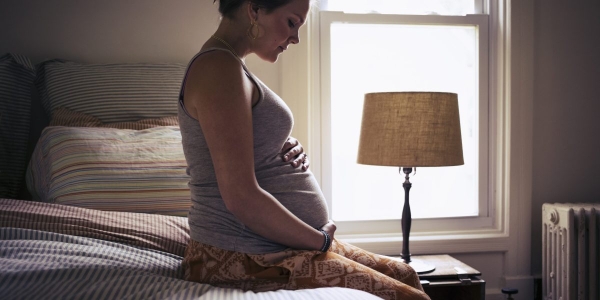
Over the past decade, the U.S. birth rate declined by roughly 20%. Maternal mortality rates, however, are rising at an alarmingly high rate, which means the number of babies being born is decreasing, while the number of women dying is increasing.
Despite having one of the most advanced health systems in the world, the U.S. currently has the highest pregnancy-related death rate among developed nations. Maternal deaths rose a staggering 40% in 2021 from just a year prior. While some of this is attributable to COVID, pre-pandemic maternal mortality levels were already steadily increasing.
Going back to the 1930s, the rate of pregnancy-related deaths in the U.S. was higher than in other comparable nations. With better maternity care, living conditions, and antibiotics, maternal mortality rates improved globally. While rates also began improving in the U.S., they began to rise again in the late 1990s, in part due to the inadequacies of the public healthcare system. As a result, the U.S. Department of Health and Human Services has deemed it a public health crisis, and the current administration has announced a call to action to improve parental and infant health outcomes.
How we got there
It’s simple: Pregnant women are not receiving the appropriate level of medical care. Racial and ethnic disparities only worsen the situation resulting in poor birth outcomes and more deaths for minorities. In 2021, the maternal mortality rate for Black women was an astounding 2.6 times higher than their white peers.
This is unacceptable and we need to do better. As an OB/GYN, I see several opportunities to effect change to improve maternal outcomes–starting with better access to health professionals, increased patient education around prenatal and postpartum care, and continued investment in maternal health initiatives.
Prenatal and postpartum care matter
Prospective parents must have access to high-quality prenatal care, which is critical for successful outcomes. Babies born to mothers who do not receive prenatal care are more likely to suffer from preterm birth and low weight, or even die.
Postpartum care is another crucial component that is often downplayed or overlooked. More than half of deaths from pregnancy complications occurred during the postpartum period, with the majority happening in the first 12 weeks. Up to 70,000 people annually experience severe postpartum issues, including cardiac and cerebrovascular challenges, leading to future fatalities. And let’s not forget the massive emotional and mental health toll that pregnancy can have, with symptoms ranging from decreased appetite and loss of sleep to depression, PTSD, or even psychosis.
Access to skilled health professionals, beginning with prenatal care, can dramatically improve mortality rates. Unfortunately, the overturn of Roe v. Wade further complicates access in multiple ways. First, it’s limiting the type of care pregnant people receive in states with restrictive abortion policies. Studies show that maternal death rates were 62% higher in states with abortion bans than those without. Further, the maternal mortality rate increased nearly twice as fast from 2018 to 2020 in states with restrictions. Secondly, it’s causing doctor shortages, especially in rural areas, forcing some patients to travel hundreds of miles to obtain maternity care. Telehealth services can help bridge some of this gap, in both rural and urban areas, to ensure pregnant people receive timely and consistent guidance and treatment, but it’s only part of the solution to a much bigger problem.
Doulas are another great resource when it comes to birthing and postpartum support. Research shows labor support from doulas can reduce physical and psychological stress during birthing and leads to higher satisfaction with the labor experience. Doulas can also provide support for healthy deliveries, including prenatal and postpartum care for women who have less access to health care.
Cesarean births are increasing for the wrong reasons and could result in more harm than good
A cesarean birth (also referred to as cesarean section or C-section) is typically recommended when vaginal delivery is considered risky. However, the number of C-sections is growing rapidly, but it’s not resulting in healthier outcomes. Cesarean births accounted for almost a third of all live births in the U.S. This rise, thought to be largely due to nonessential C-sections, has increased risks of complications and morbidity for women and infants, and is in stark contrast to the World Health Organization’s recommended rate of 15%. Data shows that between 2019 and 2021, C-sections were also highest among Black women (at 36%), compared with 31% for white women, demonstrating the role subjectivity and bias can play in health decisions.
Patient education is imperative for prospective parents to understand their options at every stage of pregnancy and feel empowered to advocate for themselves and their infants. For example, education around birthing options, including pain management, and dealing with postpartum conditions can lead to more informed care decisions. When it comes to C-sections, people should talk to their doctors to understand the risks and recovery timelines, and in some cases, may need to get a second opinion. Oftentimes, patients are scheduled for a repeat cesarean birth without being counseled on a vaginal birth after cesarean (VBAC) alternative. Experts also suggest having a midwife or doula to increase the likelihood of vaginal birth and provide postpartum support. While costs may be prohibitive, more employers are offering fertility benefits that can help defray costs for these types of services.
COVID materially worsened maternal mortality
Another contributing factor to the surge in maternal mortality was Covid-19, which accounted for 25% of maternal deaths in 2020 and 2021 combined. CDC research further shows that maternal death rates tied to COVID-related fatalities were significantly greater for Black and Hispanic women, at 13.2 and 8.9 per 100,000 live births, respectively, versus 4.5 for white women. In cases where the mother did survive, COVID still caused irreparable damage including premature births and long-term health issues for both the parent and newborn, and was worse for people of color.
With the government’s call to action to address maternal mortality and morbidity, and the spike in COVID-related deaths, we’re starting to see more health resources across the public and private sectors. For instance, the Health Resources Services Administration launched a National Maternal Mental Health Hotline with trained counselors, and the Society for Maternal-Fetal Medicine established maternal mortality review committees to prioritize interventions improving maternal health. Communities such as New York are providing free access to doulas to reduce racial inequities. Additionally, several companies have launched research and education-based programs to identify racial gaps to improve maternal outcomes.
We need to take action and advocate for change
The CDC estimates that 80% of pregnancy-related deaths are preventable. This is a clear indicator that something in our healthcare system needs to drastically change and we need to take action immediately to stop losing more lives. We must continue to raise this subject and advocate for continued investments and improvements across governmental organizations, health systems, and local communities to make quality and consistent pregnancy care available to all, starting with those from underserved communities. Only then will we begin to reverse the damage and save the lives of mothers and infants.
Asima Ahmad M.D., MPH, is the co-founder and chief medical officer of Carrot Fertility, a leading global fertility care platform for women, plus people of every age, race, income, sex, sexual orientation, gender, marital status, and geography. She is a practicing double board-certified ob/gyn and reproductive endocrinologist with an interest in mechanisms impacting global maternal mortality.
The opinions expressed in Fortune.com commentary pieces are solely the views of their authors and do not necessarily reflect the opinions and beliefs of Fortune.
More must-read commentary published by Fortune:
- IBM CEO: ‘Today’s workforce should prepare to work hand in hand with A.I.’
- Is it smart to be a ‘stupid genius’ like Elon Musk?
- Why there will be no winners in the never-ending war between Disney and DeSantis
- America’s ‘disease burden’ is getting heavier by the day–and it’s unevenly distributed across states







